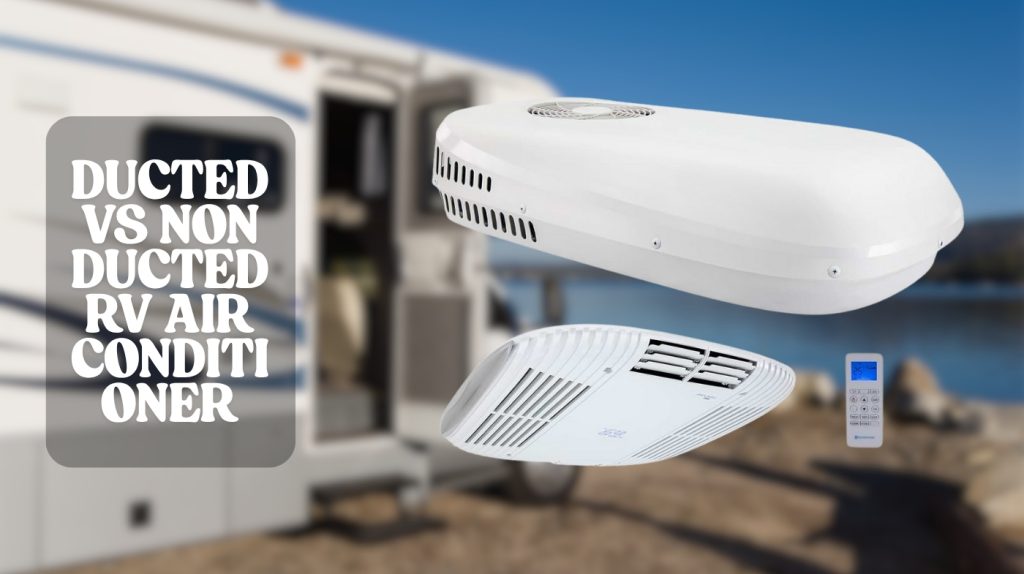Last Updated on June 5, 2025
You’ll find ducted RV air conditioners offer quieter, more uniform cooling by distributing air through ceiling ducts, making them ideal for larger RVs but with higher installation complexity and cost.
Non-ducted units mount directly on the roof for quicker, more affordable setups, cooling specific areas rapidly but often louder and less consistent. Both require regular maintenance to maintain efficiency.
If you want to understand which system best fits your RV’s size, budget, and comfort needs, there’s more to evaluate.
- Low Amp Draw for Energy Efficiency – Run multiple RV appliances without overload, perfect for…
- Durable, Road-Ready Construction – UV-resistant plastic and aerodynamic shape reduce drag and fit…
- Whisper-Quiet 55.4 dB Operation – Enjoy peaceful sleep, work, or relaxation with a noise level as…
- This is a ceiling control and distribution kit for compatible Dometic Air Conditioners..Fit Type:…
- Easy to use, adjustable
- Powerful air distribution
Key Takeaways
- Ducted RV ACs provide uniform, quieter cooling across larger spaces using ceiling ducts, ideal for multi-zone temperature control.
- Non-ducted units mount directly on the roof, offering rapid, localized cooling with simpler, faster installation suited for smaller RVs.
- Ducted systems require complex, costly installation and maintenance, while non-ducted units are more budget-friendly and easier to maintain.
- Noise levels are lower in ducted ACs due to sound dispersion, whereas non-ducted units are louder but can be mitigated with acoustic panels.
- Choose ducted ACs for larger RVs needing consistent cooling; non-ducted units fit smaller RVs with simpler layouts and budget constraints.
The Basics of Ducted RV Air Conditioners
When you rely on a ducted RV air conditioner, the rooftop unit plays a crucial role by housing the condenser coils, fans, and refrigerant necessary for heat exchange, all powered through your RV’s electrical system or a portable generator. This unit expels heat externally while maintaining interior coolness.
Choosing components with UV stabilization ensures longevity despite constant sun exposure. Inside, the Air Distribution Box (ADB) channels cooled air through ceiling ducts, equipped with replaceable filters to trap dust and adjustable fans to control airflow volume.
The duct network delivers air evenly across multiple outlets, reducing hot or cold spots and lowering noise by separating the air output from the rooftop unit. This separation helps address the common issue of noise reduction found in traditional rooftop units.
A controller and thermostat synchronize operation, cycling cooling based on ambient temperature to optimize energy use. This integrated system ensures efficient, uniform cooling tailored to your RV’s layout.
Key Features of Non-Ducted RV Air Conditioners
When choosing a non-ducted RV air conditioner, you’ll appreciate the straightforward installation since it fits standard rooftop vents without complex ductwork, keeping costs and modifications minimal.
These units deliver rapid, targeted cooling primarily to the main living area, though their airflow is limited in larger RVs. Their compact design makes them ideal for spaces where installation constraints are a concern.
Additionally, they operate quietly with noise levels typically between 43-59 dB, ensuring comfort without disruption. They are designed for non-ducted applications and include features like removable washable filters and an ultra low plenum for efficient airflow.
Installation and Cost
Although non-ducted RV air conditioners require less labor and complexity during installation, you still need to guarantee proper roof mounting, secure electrical connections, and adequate clearance for airflow. Proper maintenance and regular use of eco-friendly treatments can also help in maintaining air quality inside the RV.
The unit mounts directly on the roof, eliminating interior ductwork, which reduces installation time and labor costs. Confirm the roof structure supports the unit’s weight to maintain safety.
Connecting the system to a reliable power source is essential for efficient operation and safety. For example, the Fury on Chill model with a 15,500 BTU capacity offers a balance of power and efficiency suitable for many RVs.
Regarding cost, non-ducted units generally have a lower upfront price than ducted systems. The simplified installation reduces labor expenses, benefiting those who self-install or hire professionals. Additionally, maintenance is less costly due to fewer components.
Cooling and Noise
Non-ducted RV air conditioners offer a distinct approach to cooling by focusing on rapid, localized temperature control rather than whole-RV air distribution. You’ll notice quick temperature drops near the unit due to high BTU output and advanced compressor technology.
However, this localized cooling may cause uneven temperature across larger spaces. Because of this, selecting a unit with the right cooling capacity for your RV size is essential.
Noise levels tend to be higher since the unit sits inside your living area, but modern models include noise-dampening designs improving comfort. The Furrion Chill® Cube, known as the quietest RV air conditioner, exemplifies innovations in noise reduction for non-ducted units.
| Feature | Description |
|---|---|
| Cooling Capacity | 13,500–15,000 BTU, rapid initial cooling |
| Air Distribution | Localized, ideal for single or adjacent rooms |
| Energy Efficiency | Inverter tech and eco refrigerants reduce power |
| Noise Levels | Higher perceived noise, mitigated by design |
| User Comfort | Quick cooling, adjustable airflow, washable filters |
Comparing Installation Processes and Costs
When comparing installation complexity, ducted systems demand extensive ductwork and specialized tools, increasing both labor and material requirements. Non-ducted units offer simpler, faster setups that often suit DIY installation, reducing upfront costs considerably.
These installation factors significantly influence the overall cost efficiency of the chosen air conditioning system. Choosing the right system also depends on the available power capacity, which can be affected by your battery setup.
Installation Complexity Comparison
Since ducted RV air conditioners require integration with existing or newly installed ductwork, their installation process is inherently more complex and time-consuming than that of non-ducted units.
You’ll need to carefully plan duct placement, ensure airtight seals, and properly insulate to maintain efficient airflow and avoid leaks. Specialized tools and expertise are essential for modifying or installing ducts, balancing air pressure, and fitting vent grills.
In contrast, non-ducted units simplify installation by mounting directly to the roof without structural modifications. They come pre-assembled, requiring only electrical and drainage connections, which considerably reduces labor and time.
Additionally, roof-mounted units like the Dometic Penguin 2 involve careful wiring and sealing steps to prevent leaks and ensure proper operation. For protection during installation, using weather-resistant materials similar to those found in caravan awnings can help safeguard components from environmental damage.
While ducted systems may take several hours or days, non-ducted setups often complete within a day, making them more straightforward for DIY or quick professional installation.
Noise Levels and Operational Efficiency
Although both ducted and non-ducted RV air conditioners serve the same purpose, they differ considerably in noise levels and operational efficiency. Ducted systems operate quieter because sound disperses through ductwork, making them roughly 1.1 times quieter than non-ducted units, which concentrate compressor and fan noise near living spaces.
This quieter operation suits frequent or extended use. Modifications such as adding an acoustic panel to separate intake and output airflow can reduce noise by 9-11 dB, significantly improving comfort in non-ducted units by redirecting sound away from living areas and cutting vibrations noise reduction.
Many RV owners also consider durability and maintenance when choosing between these systems, as ducted units typically require less frequent servicing due to their protected components.
Operationally, ducted air conditioners improve energy efficiency by distributing cool air evenly, reducing runtime and energy waste, especially in larger RVs. In contrast, non-ducted units focus cooling near the unit, causing uneven temperature zones and longer runtimes, increasing energy consumption.
While simpler and cheaper upfront, non-ducted units often require more maintenance and produce intrusive noise, which may impact overall operational efficiency and user comfort over time.
Cooling Performance and Temperature Distribution
When you choose an RV air conditioner, cooling performance and temperature distribution are critical factors that directly impact comfort. Ducted systems excel in powerful, uniform cooling, especially in larger RVs with multiple rooms, by distributing air through a network of vents.
This design allows for quieter operation compared to non-ducted units, enhancing the overall comfort inside the RV. Their ability to maintain consistent temperature control throughout the space is similar to how G rated trailer tires provide reliable performance under heavy loads.
Non-ducted units deliver cool air directly, offering efficient, localized cooling ideal for smaller spaces. Understanding these differences helps you select the best option for your RV size and layout.
- Ducted systems provide consistent cooling across multiple zones, minimizing hot spots
- Non-ducted systems focus cooling near the unit, potentially causing uneven temperature
- Ducted setups handle larger spaces efficiently with centralized air distribution
- Non-ducted units save energy and simplify installation in compact RVs
- Uniform temperature control in ducted systems enhances overall cooling efficiency
Maintenance Requirements and Longevity
Because regular upkeep directly impacts your RV air conditioner’s reliability and lifespan, you need to prioritize consistent maintenance tasks. Inspect and clean or replace air filters monthly if you use your RV full-time, or quarterly otherwise, to maintain airflow and prevent system strain.
Biannually, check the exterior shroud for damage and clean condenser coils to ensure efficient heat exchange. Monitor seals and gaskets to prevent moisture leaks that can cause internal damage and mold. Running the system periodically during storage keeps mechanical components lubricated and refrigerant properly circulated.
For ducted units, also clean ducts to avoid dust buildup. Scheduling biannual professional inspections complements your routine, identifying hidden issues and extending the system’s service life. Neglecting these steps considerably reduces performance and shortens the AC’s operational longevity.
Additionally, selecting repair products with UV-resistant properties can help maintain the durability of outdoor components exposed to sunlight.
Choosing the Right System for Your RV Size and Needs
Maintaining your RV air conditioner sets the stage for selecting the right system tailored to your RV’s size and specific needs. When choosing between ducted and non-ducted systems, consider your RV’s dimensions and power capacity. The key factor that influences whether an RV uses a ducted or non-ducted system is the interior ceiling assembly.
Larger RVs benefit from ducted systems offering uniform cooling and quieter operation, despite higher installation complexity and energy use. Smaller to mid-size RVs suit non-ducted models, which are simpler, cost-effective, and space-efficient.
Key considerations include:
- RV size and layout compatibility
- Cooling capacity and air distribution needs
- Installation complexity and available space
- Electrical capacity and energy consumption
- Budget constraints and long-term value
Frequently Asked Questions
Can Ducted Systems Be Retrofitted Into Older RVS?
Think of retrofitting a ducted system like fitting a new engine into an old car, it’s doable but requires skill. Yes, you can retrofit ducted AC into older RVs, but it involves custom duct installation, structural modifications, and ensuring compatibility with existing systems.
You’ll need to optimize airflow and seal ducts properly to prevent leaks. Given the complexity and cost, hiring a professional is highly recommended for a successful retrofit.
Do Non-Ducted Systems Affect RV Battery Life More?
You’ll find non-ducted systems generally use less power, which helps conserve your RV’s battery life. They cool spaces quickly and don’t require energy-hungry air distribution through ducts.
Plus, their simpler installation reduces electrical losses. However, actual battery impact depends on usage patterns and system specs.
Are Ducted Air Conditioners Compatible With Solar Power Setups?
Yes, you can run ducted air conditioners on solar power, but you’ll need a robust solar setup. These units demand high wattage often over 3000W so your solar panels, batteries, and inverter must handle startup surges and continuous loads.
Optimizing battery capacity and panel array size is vital for reliable operation. Proper system sizing and efficiency considerations ensure your ducted AC works smoothly off-grid with solar energy.
How Do Weather Conditions Impact Each System’s Efficiency?
Oh, sure, Mother Nature loves cranking up the heat just to test your patience and your AC’s efficiency. When temperatures soar above 100°F, both systems strain harder, gulping more power.
Ducted units spread cool air evenly, managing humidity better, while non-ducted ones target zones quickly but struggle with moisture buildup. High heat and humidity demand more maintenance and energy from your system, so regular care is vital to keep your RV comfortable and efficient.
Can Either System Be Integrated With RV Smart Home Technology?
You can integrate both ducted and non-ducted RV air conditioners with smart home technology using smart thermostats, voice assistants, and mobile apps. While ducted systems may require more complex setup due to ducts and higher power use, non-ducted units offer simpler, more flexible integration.
Brand-specific or third-party devices enhance compatibility. Energy monitoring and remote control features work well with both, letting you optimize comfort and efficiency in your RV smart home system.
Finding the Perfect Fit: Comfort, Cost, and Cooling Priorities
Whether you choose ducted or non-ducted RV air conditioners, you’ll find that both systems offer distinct advantages tailored to different needs. Coincidentally, your decision often hinges on factors like installation complexity, noise tolerance, and cooling coverage.
By carefully weighing these elements against your RV’s size and usage, you’ll pinpoint the most efficient, cost-effective solution. Ultimately, understanding these technical differences guarantees you stay comfortable on the road without compromising performance or maintenance ease.
- Energy-Efficient Low Amp Draw – Our RecPro RV air conditioner is engineered with a low amp draw,…
- Rugged, Durable Design Built for Travel – Made from durable, UV-resistant plastic, this rooftop…
- Ultra-Quiet Operation – Just 59.7 dB – Say goodbye to loud, disruptive units! With a noise level…
- Note: FOGATTI RV air conditioners require connection to both 115V AC power and 12V DC power.
- Fast Cooling: Fogatti RV Air Conditioner has dual high-efficiency compressors and 13,500 BTU…
- Efficient Energy Saving: Fogatti RV AC not for ducted features an optimized fan and smart…
Last update on 2025-12-18 / Affiliate links / Images from Amazon Product Advertising API






